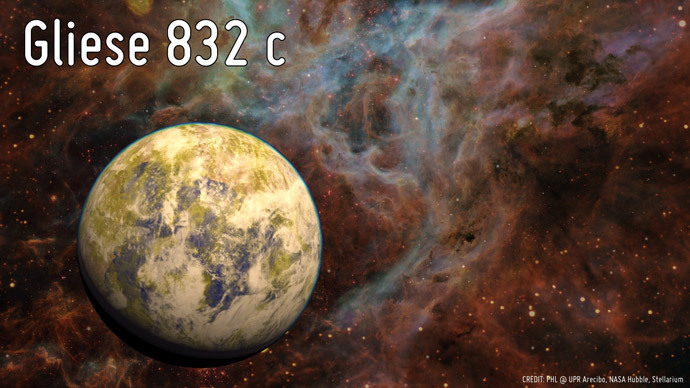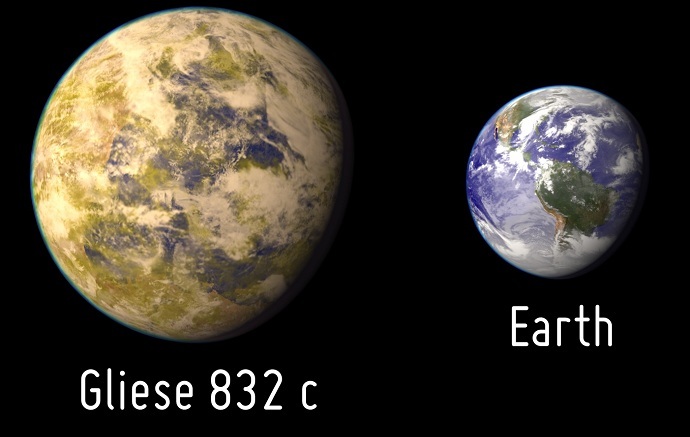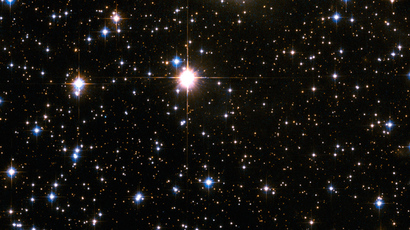Potentially habitable ‘super-Earth’ discovered ‘just’ 16 light years away

Scientists have added a new planet to their Habitable Exoplanets Catalog, Gliese 832c, which orbits a nearby red dwarf star, receives the same average energy from its sun as Earth does – potentially making it the most Earth-like planet yet.
The group of international astronomers, led by Dr. Robert Wittenmyer at the University of New South Wales in Australia, discovered the “super-Earth,” which is located 16 light years from our home planet. According to Discovery News, it orbits a red dwarf star – a small, dim star that generates far less energy than our Sun.
The red dwarf star, Gliese 832, has about half the mass and radius of the sun and is located in the constellation Grus. The star also has a cold, Jupiter-like planet orbiting it, which was discovered in 2009.
“With an outer giant planet and an interior potentially rocky planet, this planetary system can be thought of as a miniature version of our Solar System,” Professor Chris Tinney, an astronomer and co-author of the discovery paper accepted for publication in the Astrophysical Journal, said in a UNSW statement.
If Gliese 832c has a similar terrestrial atmosphere to Earth, it might have similar temperatures – but seasonal shifts would be extreme. The new exoplanet’s average equilibrium temperature of 253 degrees Kelvin is similar to Earth’s, which is 255 degrees Kelvin. It takes 35.68 days to orbit the red dwarf and has a mass that is 5.4 times the size of Earth’s.

“Given the large mass of the planet, it seems likely that it would possess a massive atmosphere, which may well render the planet inhospitable,” Tinney said. “A denser atmosphere would trap heat and could make it more like a super-Venus and too hot for life.”
Like Venus, Gliese 832c is probably enduring intense warming caused by a runaway greenhouse effect, Discovery News reported. In this case, although the planet’s orbital location should allow liquid water to persist, any water would likely be ripped apart on a molecular level by intense atmospheric heating and ultraviolet light from the red dwarf star, a process known as dissociation.
However, scientists do not know what the planet’s atmosphere is like, including what gases and other chemicals it might contain.
Because its orbital path is on the inner boundary of the “habitable zone,” defined by Space.com as “the just-right range of distances that could allow liquid water to exist on a world’s surface,” scientists believe Gliese 832c is the most Earth-like planet yet. Its Earth Similarity Index (ESI) is 0.81. An Earth-twin would have an ESI of 1.0.
“This makes Gliese 832c one of the top three most Earth-like planets according to the ESI (i.e., with respect to Earth’s stellar flux and mass) and the closest one to Earth of all three — a prime object for follow-up observations,” Able Mendez Torres, director of the Planetary Habitability Laboratory (PHL) at the University of Puerto Rico, wrote in the PHL blog.
The other two Earth-like planets Mendez referred to are Gliese 667Cc, with an ESI of 0.84, and Kepler-62e, with an ESI of 0.83.
Gliese 832c was discovered from its gravitational pull on the red dwarf star, which causes the star to wobble slightly, according to Sci-News.com. The astronomers used the Anglo-Australian Telescope, the 6.5-m Magellan Telescope, and the European Southern Observatory 3.6-m to make their discovery.














